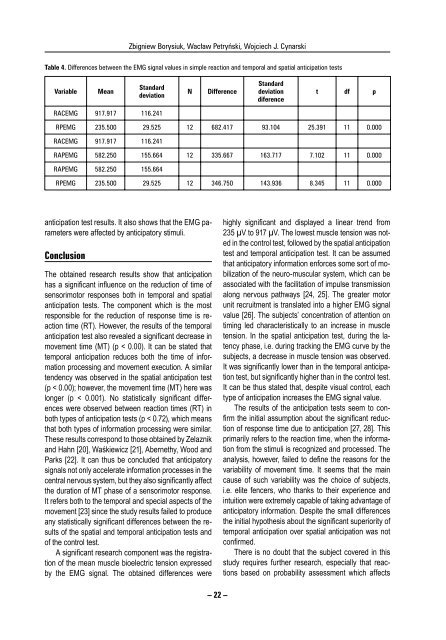Antropomotoryka nr 51 - Akademia Wychowania Fizycznego w ...
Antropomotoryka nr 51 - Akademia Wychowania Fizycznego w ...
Antropomotoryka nr 51 - Akademia Wychowania Fizycznego w ...
- No tags were found...
Create successful ePaper yourself
Turn your PDF publications into a flip-book with our unique Google optimized e-Paper software.
Zbigniew Borysiuk, Wacław Petryński, Wojciech J. CynarskiTable 4. Differences between the EMG signal values in simple reaction and temporal and spatial anticipation testsVariableMeanStandarddeviationNDifferenceStandarddeviationdiferencet df pRACEMG 917.917 116.241RPEMG 235.500 29.525 12 682.417 93.104 25.391 11 0.000RACEMG 917.917 116.241RAPEMG 582.250 155.664 12 335.667 163.717 7.102 11 0.000RAPEMG 582.250 155.664RPEMG 235.500 29.525 12 346.750 143.936 8.345 11 0.000anticipation test results. It also shows that the EMG parameterswere affected by anticipatory stimuli.ConclusionThe obtained research results show that anticipationhas a significant influence on the reduction of time ofsensorimotor responses both in temporal and spatialanticipation tests. The component which is the mostresponsible for the reduction of response time is reactiontime (RT). However, the results of the temporalanticipation test also revealed a significant decrease inmovement time (MT) (p < 0.00). It can be stated thattemporal anticipation reduces both the time of informationprocessing and movement execution. A similartendency was observed in the spatial anticipation test(p < 0.00); however, the movement time (MT) here waslonger (p < 0.001). No statistically significant differenceswere observed between reaction times (RT) inboth types of anticipation tests (p < 0.72), which meansthat both types of information processing were similar.These results correspond to those obtained by Zelaznikand Hahn [20], Waśkiewicz [21], Abernethy, Wood andParks [22]. It can thus be concluded that anticipatorysignals not only accelerate information processes in thecentral nervous system, but they also significantly affectthe duration of MT phase of a sensorimotor response.It refers both to the temporal and special aspects of themovement [23] since the study results failed to produceany statistically significant differences between the resultsof the spatial and temporal anticipation tests andof the control test.A significant research component was the registrationof the mean muscle bioelectric tension expressedby the EMG signal. The obtained differences werehighly significant and displayed a linear trend from235 µV to 917 µV. The lowest muscle tension was notedin the control test, followed by the spatial anticipationtest and temporal anticipation test. It can be assumedthat anticipatory information enforces some sort of mobilizationof the neuro-muscular system, which can beassociated with the facilitation of impulse transmissionalong nervous pathways [24, 25]. The greater motorunit recruitment is translated into a higher EMG signalvalue [26]. The subjects’ concentration of attention ontiming led characteristically to an increase in muscletension. In the spatial anticipation test, during the latencyphase, i.e. during tracking the EMG curve by thesubjects, a decrease in muscle tension was observed.It was significantly lower than in the temporal anticipationtest, but significantly higher than in the control test.It can be thus stated that, despite visual control, eachtype of anticipation increases the EMG signal value.The results of the anticipation tests seem to confirmthe initial assumption about the significant reductionof response time due to anticipation [27, 28]. Thisprimarily refers to the reaction time, when the informationfrom the stimuli is recognized and processed. Theanalysis, however, failed to define the reasons for thevariability of movement time. It seems that the maincause of such variability was the choice of subjects,i.e. elite fencers, who thanks to their experience andintuition were extremely capable of taking advantage ofanticipatory information. Despite the small differencesthe initial hypothesis about the significant superiority oftemporal anticipation over spatial anticipation was notconfirmed.There is no doubt that the subject covered in thisstudy requires further research, especially that reactionsbased on probability assessment which affects– 22 –





![Antropomotoryka nr 57 [2012]. - Akademia Wychowania Fizycznego ...](https://img.yumpu.com/50213388/1/182x260/antropomotoryka-nr-57-2012-akademia-wychowania-fizycznego-.jpg?quality=85)










